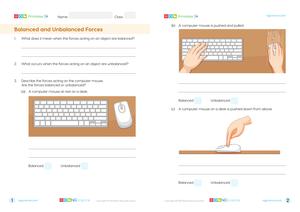Begin the lesson by introducing the concept of force as a push or a pull. Use everyday examples such as pushing a door open or pulling a drawer to engage students.
Go to the LessonLearning Objectives
- Understand that a force is a push or a pull that can change the motion, speed, direction, or shape of an object.
- Recognize the difference between balanced and unbalanced forces and their effects on an object's motion.
- Identify examples of push and pull forces in everyday life.
- Explain the relationship between the magnitude of a force, the mass of an object, and the effect on the object's motion.
- Demonstrate how greater mass requires a larger force to achieve the same change in motion as a smaller mass.
Introduction and Hook
Direct Instruction
Explain the difference between balanced and unbalanced forces and their effects on an object's motion. Use diagrams to illustrate these concepts.
Discuss the relationship between force magnitude, mass, and motion. Use examples such as lifting a soccer ball versus a bowling ball to demonstrate how greater mass requires larger force.
Guided Exploration
Engage students in a discussion about push and pull forces in their daily lives. Encourage them to share examples and relate them to the concepts learned.
Hands-On Activity
Conduct a simple experiment where students use different weights to see how much force is needed to move them. This activity demonstrates the relationship between mass and force.
Independent Practice
Check for Understanding
Facilitate a class discussion to review key concepts such as balanced and unbalanced forces, and the effects of force magnitude on motion.
Review and Reflection
Encourage students to reflect on what they have learned about forces. Ask them to write a short paragraph on how they observe forces in their everyday life.
Assessment and Extension
Conclude the lesson with a quiz to test comprehension of the forces unit. This quiz helps assess students' grasp of key concepts.
Try the Quiz






